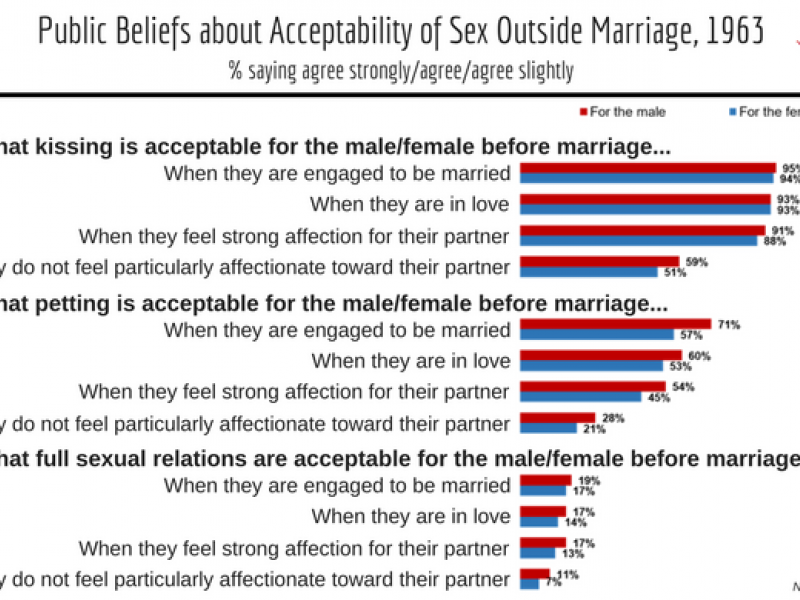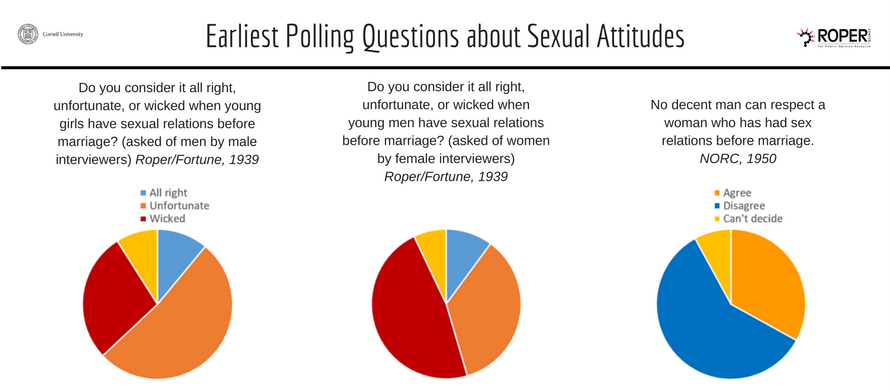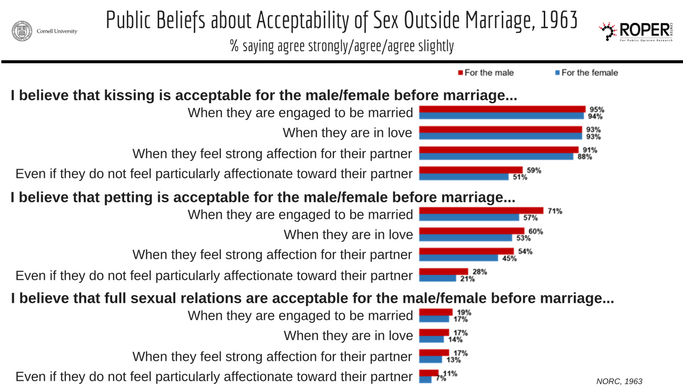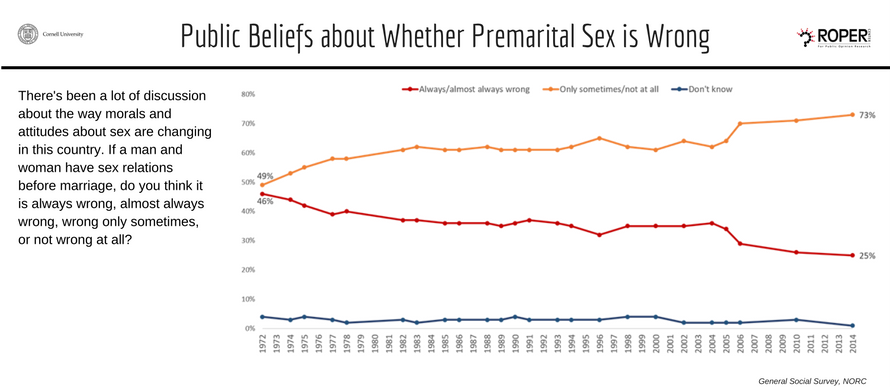
Fifty years ago during the Summer of Love, the emerging hippie subculture captured the attention of the nation. Young people outraged their elders with unconventional haircuts, clothes, and music; skeptical attitudes about property and traditional religion, and, perhaps most shockingly, belief in free sexual expression outside the bounds of marriage. Public opinion polling from the time indicates that the counterculture position on “free love” was indeed antithetical to the majority view of marriage as a morally necessary precondition for sexual activity. But the poll questions themselves also reveal an increasing openness about sexuality in the 1960s that preceded and anticipated major changes in public attitudes.
Something “Wicked”: Polling on Sex Pre-1960
The language of the archive’s earliest polling question on sexuality has not aged well. A 1939 Roper/Fortune survey first broached the subject of morality of sexual relations by asking if it was “all right, unfortunate, or wicked” for young men and women to have sexual relations before marriage. Interestingly, the question about young “girls” was posed only to men, and that about young “men” only to women. More importantly, these questions were only asked of respondents of the same sex as their interviewer. The subject of sex was seemingly too delicate to be discussed between the sexes, even in a research context.
In 1943, Roper revisited this question, asking only women their perceptions of sex before marriage for both sexes. A slightly larger proportion said it was “wicked” for young girls (46%) to have premarital sex than said the same about young men (37%).
In 1950, a NORC poll asked respondents whether they agreed with the statement: “No decent man can respect a woman who has had sexual relations before marriage.” Just 29% agreed. In 1953, NORC refielded the question, with similar results (33%). These results may seem surprisingly positive about premarital sexual activity, particularly in light of the earlier Roper questions; however, the strong wording of the statement, while providing a socially acceptable framework for the question, may have triggered a high negative response.
These questions represented nearly all those asked about the morality of sex in a general sense before 1960. Polls in the thirties, forties, and fifties occasionally touched on matters related to sex, like birth control and management of venereal disease in the military. But generally such subjects were skirted.
Let’s Talk about Sex: Polling in the ‘60s
The turn of the decade marked an increase in questions about sexuality. While the overall Roper Center polling archive holds slightly more questions from the 1950s than the 1960s, the number of questions about sex shifted from just 13 in the 1950s to 94 in the 1960s. A 1962 survey of American women, married and unmarried, delved into issues including whether women of the respondents’ acquaintance discussed sexual matters frankly with each other (48% of married women said yes), whether most husbands were sexually satisfied with their wives and vice versa, and whether respondents knew any married people who were having sexual affairs. Women were also asked if moral standards in the country had changed. While 25% said no, 44% said moral standards had become too loose, 10% that there was too much sex, and 11% that sex was discussed too openly. Those giving the latter answer might have felt the survey itself, with its candid questions, was a fine case in point.
A battery of questions asked by NORC in 1963 delved deeply into American attitudes about premarital sexual activity, with neutral questions that differentiated between the sexes, the level of relationship, and the type of sexual behavior. While some behaviors were considered more acceptable for young men than young women (particularly “petting” when engaged to be married), the greatest distinctions were between the level of sexual involvement, not the sex of the participant or even the relationship between the parties involved. Very few Americans thought premarital sex was acceptable for anyone. Even when asking about young men or women engaged to be married, the survey found fewer than one in five who considered premarital sex acceptable.
By mid-decade, pollsters were specifically addressing the question of cultural changes in sexual attitudes. In 1964, Gallup asked if Americans believed there had been a change in attitudes towards sex since the end of World War II. Over half (56%) said there had been a great change, and 26% some change. Only 13% said there hadn’t been much change at all. Sixty-four percent of respondents in the same survey said that teenagers today had different attitudes about sex than they did when they were teenagers.
Another indicator of changing attitudes was the inclusion of a question about homosexuality in a 1965 Harris poll, a subject never before broached in public opinion polling. The public was disapproving overall: Seventy percent said homosexuals were more harmful than helpful to American life, though 29% said they neither harmed nor helped. But the topic had been raised, and when the question was repeated in 1969, just after the Stonewall riots, the proportion saying homosexual people were harmful had shifted downward slightly, to 63%.
May I Speak Frankly? The 1970s
Despite the greater openness in polling questions, there was little in the actual responses in the 1960s to indicate that Americans’ attitudes toward sexual matters had changed substantially. A 1969 Gallup poll found that just 21% thought it was not wrong for a man and woman to have sex before marriage.
In 1972, NORC started the General Social Survey (GSS), an ongoing series of polls on social attitudes. The question GSS used about premarital sex was more nuanced than Gallup’s, allowing a range of responses from “not at all wrong” to “always wrong.” In the first GSS study, the public was nearly evenly split between those who thought that sex outside marriage was wrong only sometimes or not at all and those who thought it was always or almost always wrong. Since then, the proportion who think premarital sex is always or almost always wrong has drifted slowly downward, reaching a low of 25% in 2014.
Over the next few years, GSS added questions about pornography and sexual activity with someone other than one’s spouse. NORC wasn’t the only survey research organization to tackle these new areas. Over the course of the seventies, any reticence pollsters may have shown towards asking questions about sex disappeared. Polls now covered topics including women’s sexual satisfaction; discrimination against gay people, acceptability of homosexual behavior, and mothers “becoming active lesbians”; cohabitation; sexual infidelity; prostitution; and venereal disease. Polls of women became particularly personal, asking whether respondents’ pregnancies had been planned, whether they spoke as frankly about sex with men as with women, and whether the respondents themselves were sexually fulfilled.
Such questions represented an enormous change from delicate inquiries about “wickedness”. In a 1978 Yankelovich, Skelly & White poll of adults in families, 63% said they welcomed the more open talk about sex in today’s society. The public opinion research community surely agreed, as the increased candor about sex that emerged in the 1960s introduced a whole new world of American attitudes and behaviors for survey researchers to explore.
Kathleen Weldon is Director of Data Operations and Communications at the Roper Center. She manages data provider relations, oversees the data curation process, plans archival development, and works closely with the IT development team in building new user tools.



